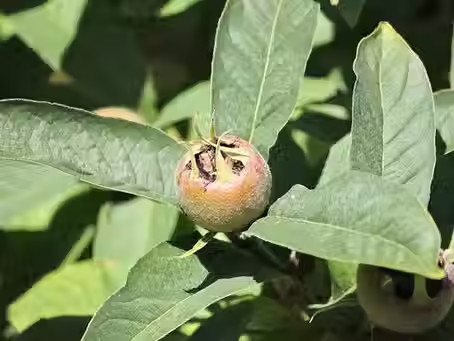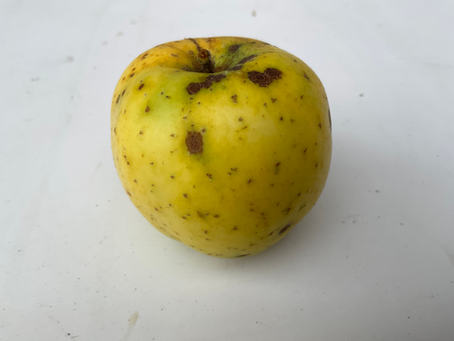top of page

pendragon orchard and vine
Turning Landscape into Legacy
Blog
Subscribe for writing that turns landscapes into legacies
Search


Defiance, Part I: The Last Apple Standing
I love this apple for its defiance. It’s the ultimate winter keeper apple. It is also one of the most balanced apples I’ve had—sweet, acidic, and without the penalty that plagues so many late hangers. The skin isn’t that tough, battlefield-leather armor you get with other winter apples. It’s firm, yes, but fair. The history, its endurance, though, makes it worth having.
Wolfy
4 hours ago4 min read


Defensive Design: How to Build Edible Landscapes That Survive Reality
It’s the classic social-media reflex: someone posts a leaf with a wrinkle, and five seconds later a stranger hollers leaf curl! as if pronouncing a curse.
Wolfy
3 days ago7 min read


Winter Garden: What My Grandfather’s War Garden Still Teaches Me - Part 2
They understood that certain transformations only happen slowly, in the cold. That winter isn’t an obstacle but a collaborator. That time itself is a tool, if you know how to wield it. Most modern people try to fight winter. Japan fermented it.
Wolfy
6 days ago7 min read


Winter Garden: What My Grandfather’s War Garden Still Teaches Me
Before sunrise, I walk the wind-cut rows of my winter garden on Orcas, gathering lettuce, kale, and collards for breakfast. As frost clings to the leaves, I’m reminded of my grandfather’s wartime garden—how his acre kept neighbors alive when winter meant scarcity, not inconvenience. That memory becomes a doorway into older worlds where people survived the cold without refrigerators, grocery stores, or modern rescue.
Wolfy
Nov 136 min read


Growing Wine Grapes in Seattle? Part 3: Earth, Wind, and Wire
And so, wine grape establishment in the Seattle climate becomes less about planting and more about designing a dialogue—between root and rainfall, between leaf and wind, between earth, wind, and wire.
Wolfy
Nov 36 min read


From Soil to Cell: How Nutrient-Dense Gardens and Landscapes Rebuild Human Resilience
The first act of cultivation is not planting — it’s inquiry. Test the soil. Read its chemistry and its silence. Some soils are burdened — with metals, residues, or exhaustion from years of extraction. Others are simply asleep, waiting to be woken. You must know which you have before asking it to feed you.
Tamayo
Oct 287 min read


Sweet After the Freeze: Remembering Growing, and Eating the Medlar
Long after apples are gone and pears are stored away, the medlar still hangs—brown, frost-touched, and waiting. It’s a fruit that sweetens only after the cold, a reminder that not everything worth tasting comes in season.
Wolfy
Oct 134 min read


A Road Made of Roots: Notes on Wild Apples, Design, and Inheritance
I found the tree four years ago, growing out of a ditch outside Eastsound. A wild apple, balanced and bright, that led me into older work—of grafting, inheritance, and the quiet restoration that real design requires.
Wolfy
Oct 84 min read


Designing Fragrant Gardens for the Pacific Northwest
For millennia, fragrance guided the design of gardens — from Persian courtyards to monastic cloisters. Today it’s often missing. In the Pacific Northwest, restoring scent means designing with intimacy, ecology, and time.
Wolfy
Oct 74 min read


A Strawberry Tree Grows in Seattle: Rediscovering an Ancient Evergreen — Top 10 Permaculture Species
The strawberry tree (Arbutus unedo) is an ancient evergreen too often overlooked in the Pacific Northwest. While other trees retreat into winter, it carries blossoms and ripening fruit side by side, offering color, nectar, and sustenance when little else remains. Once woven into Roman myth and Mediterranean culture, today it survives mostly as an ornamental—yet its resilience, drought tolerance, and quiet gifts make it a tree worth reclaiming for our landscapes.
Wolfy
Sep 305 min read


Growing Wine Grapes in Seattle? Part 2: Variety and Rootstock
Growing grapes west of the Cascades isn’t about chasing the biggest names—it’s about matching what you plant to the heat, soil, and season you actually have. Varieties that ripen in 1400–2300 GDD and rootstocks that can handle pests, low pH, and wet soils are the difference between fruit worth crushing and years of disappointment. Like raising kids, success comes from giving them the right foundation and the right place to grow.
Wolfy
Sep 278 min read


Edible Landscape Design with Pacific Northwest Natives: Hawthorn — Top 10 Permaculture Species
The Native Workhorse Hiding in Plain Sight Across the Pacific Northwest is, Arguably, the Ultimate Species for Edible Landscapes.
Wolfy
Sep 195 min read


Growing Olives in the Pacific Northwest: History, Survival, Struggle, and the Long Bet.
Every olive carries history in its roots — Athens crowned with Athena’s gift, Noah reading the branch as landfall, empires rising and falling while the trees still bore fruit. To plant one here is to graft that long memory into Northwest soil, a wager that what endured for millennia might endure again.
Wolfy
Sep 178 min read


Growing Wine Grapes in Seattle? Part I: Climate and Site Selection
You can grow wine grapes in Western Washington—if you pick the right varieties and stay ahead of powdery mildew. Forget the mystique; with soil, sun, water, and patience, a backyard vineyard is within reach.
Wolfy
Sep 107 min read


Growing Figs in the Pacific Northwest: A Practical Guide for Growers
Figs aren’t just for the Mediterranean. In the Pacific Northwest, a handful of hardy cultivars thrive with the right microclimate and pruning. Learn which varieties deliver, how to favor breba crops over late-ripening duds, and why now is the best time to experiment with figs in Cascadia.
Wolfy
Sep 85 min read


Gardening Bootcamp - 8 Beginning Mistakes That Will Cost You
From bad plant choices to nightly deer raids, here’s what sinks most first-time gardens.
Wolfy
Sep 83 min read


Edible Landscape Design: A Chestnut is True Generational Wealth — Top 10 Permaculture Species
Chestnuts aren’t just nut trees — they’re living inheritance. From ancient groves in Italy still feeding families after 500 years to young orchards rising in the Northwest, these trees promise shade, food, and continuity long after we’re gone. Plant a pair today and you’re building more than a food forest — you’re building generational wealth.
Wolfy
Sep 43 min read


Edible Landscape Design: Aronia (Chokeberry) — Top 10 Permaculture Species
Why Aronia (Chokeberry) Is the Shrub That Crushes Blueberries in Nutrition, Resilience, and Design
Tamayo
Sep 34 min read


Edible Landscape Design: Russian Comfrey — Top 10 Permaculture Species
Russian comfrey isn’t a crop you grow and forget — it’s a permanent fixture in the food forest. The sterile Bocking 14 hybrid won’t spread by seed, but once rooted it becomes a long-term nutrient engine, pulling minerals from deep in the soil and cycling them into leaves you can cut again and again. We plant it around fruit trees not only for its mulch and pollinator blooms, but also as a living barrier that keeps out runner grasses.
Wolfy
Sep 13 min read


Edible Landscape Design: Jerusalem Artichoke (Sunchoke) — Top 10 Permaculture Species
A dense patch of Jerusalem artichokes with tall green stalks and bright yellow sunflower-like blooms, growing along a hillside with trees in the background.
Wolfy
Aug 293 min read
bottom of page